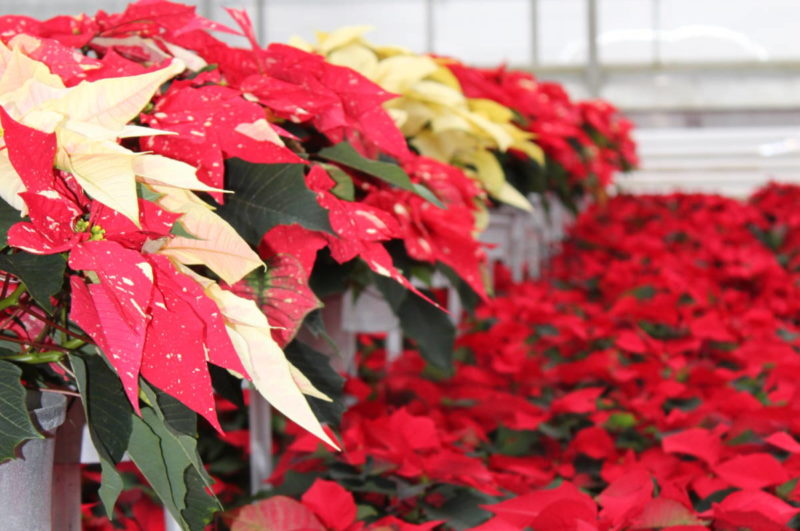
Protecting Poinsettias Through Shipping and Finishing Strong
With fall now upon us, poinsettia production is in full swing. From mid-season to finish, it is important to continue watching for common pest and disease problems, such as whiteflies and foliar diseases. Closely monitoring plants and recognizing problems early allows you to make corrective actions sooner, so crop quality is not put at risk.
GAIN CONTROL OF COMMON DISEASES
The most common diseases you may encounter when growing poinsettias are:
Alternaria and Xanthomonas leaf spots. Alternaria leaf spots begin as small lesions with a tan center and dark margins. They are somewhat rounded and usually surrounded by a chlorotic tissue. As the infection spreads, the leaf will become more chlorotic and drop from the plant. These spots can easily be mistaken for bacterial leaf spot caused by Xanthomonas axonopodis.
Infections by Xanthomonas spp. cause small, angular-shaped spots with dark, brown margins. If you hold the leaf up toward the light, you may notice water-soaked tissue around the margin of the lesion. These lesions may also be surrounded by chlorotic tissue.

Keeping water off the foliage will help reduce the spread and severity of fungal and bacterial leaf spot diseases. Many of the fungicides used in poinsettia production have good activity against Alternaria sp. Products containing copper, such as Phyton 27, Camelot and Kalmor fungicides, and biologicals such as Triathlon BA and Cease biofungicides, may help minimize the spread of bacterial diseases.
Botrytis. Botrytis thrives in cool, humid environments and can be particularly problematic in the later part of poinsettia production. Initial infections cause water-soaked, V-shaped lesions on the foliage and bracts. Once established, the mold can quickly spread throughout the crop and production area.
Powdery mildew. Powdery mildew can be a problem on poinsettias produced in cooler regions of the country. Infections initially appear as small, chlorotic spots on the foliage that are soon covered with white, fluffy colonies of the fungus. Over time, they increase in size and number to cover the plants’ surface, reducing growth and causing leaves to turn yellow, brown and then drop.
KEEP WHITEFLIES AWAY
By far, the most significant and damaging pest on poinsettias is the whitefly. Adult and immature whiteflies have piercing-sucking mouthparts that are inserted into the phloem and extract plant sap, which affects plant vigor. Indications of whitefly activity include:
• Reduced leaf expansion
• Yellowing of foliage
• Sticky honeydew secretions and black sooty mold growth on the upper surface of leaves

Whitefly populations can build quickly, so scouting every week is essential. Examine the undersides of leaves in the lower, middle and upper canopy for nymph activity. A small 20x hand lens will come in handy when assessing life stages. Monitoring pest activity weekly will help gauge insect pressure and the performance of your control program.
POINSETTIA AGRONOMIC PROGRAM
Plant protection products are essential when environmental conditions are conducive to pest development or when symptoms are first observed. The frequency of applications should be based on the activity of the product, current environmental conditions, pest lifecycle and level of pressure. Additionally, it is critical to proactively delay the development of resistance by rotating products with different modes of action.
Syngenta has developed an agronomic program (see Table 1) for poinsettia production that provides proven recommendations to prevent pests and diseases that can impact the quality of your crop. It proposes control options when they will be most beneficial based on their strengths, modes of action and length of control. Since pressure can vary by region, the program is meant to be a guide, offering a built-in resistance management strategy that will reduce problems, eliminate the need for corrective actions and help ensure the production of a high-quality crop.
FINISHING PRODUCTION WITH A PGR DRENCH
In the final weeks leading up to shipping your poinsettia crop, a drench application of Bonzi plant growth regulator (PGR) can be used to hold the crop at the desired size. This application should be applied two to three weeks before shipping or when the crop is 1 inch below the desired finish height. Application rates will vary depending upon the region of production and vigor of the variety. In Northern climates, apply Bonzi drenches using rates of 0.5 to 1 ppm. In Southern climates, slightly higher rates of 1 to 2 ppm can be used and applied as early as four weeks before finishing, particularly on vigorous varieties. Under very hot conditions, such as in south Florida, a second application may be applied if needed. It is always important to make sure the growing media is evenly moist (not wet) before making the drench application and moisture levels are similar from pot to pot. This will ensure the PGR is absorbed evenly and the response will be more predictable.
HOLDING STEADY
In the South, PGR applications using low dose, micro-drenches can be used earlier in production, after pinch, to manage plant height. This should be done with careful monitoring and graphical tracking to help you gauge when applications are required. Use rates for microdrenches range from 0.1 to 0.2 ppm.
While every greenhouse and nursery operation are different, one consistent factor common to all is that preparation is key to success. Growing poinsettias for winter sales means having to deal with the challenges that production can bring. By planning ahead with an agronomic program, you are prepared for when expected and unexpected problems arise.


 Video Library
Video Library 




















